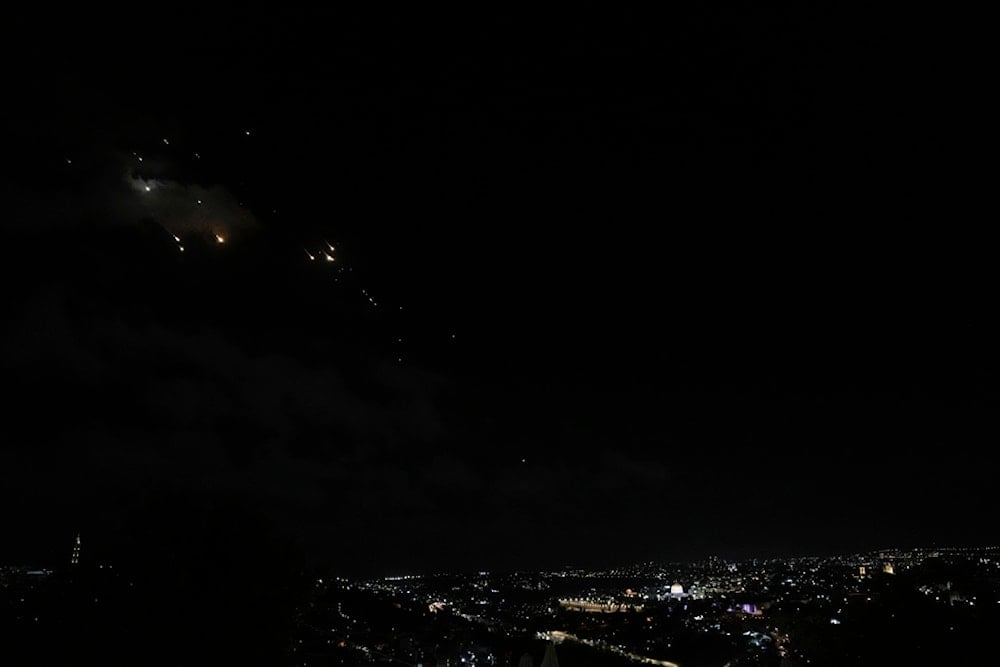THAAD transfer to 'Israel' points to crisis in defense systems: Report
The United States sending a THAAD battery to the Israeli occupation signals underlying issues pertaining to strains and limitations.
-

Rockets are seen over occupied al-Quds as a siren sounds a warning of incoming missiles fired from Iran, in al-Quds, occupied Palestine, Tuesday, October 1, 2024 (AP)
The United States deploying Theater High Altitude Air Defense (THAAD) missiles to occupied Palestine highlights growing concerns over the state of missile defense systems in both the US and the Israeli occupation, the National Interest reported on Thursday.
The THAAD system, designed to complement the existing Patriot system, offers protection over a wider area with a range of 150-200 kilometers (93-124 miles), making it capable of intercepting ballistic missile threats. Each battery is composed of six truck-mounted launchers, 48 interceptors, and advanced radar and radio equipment, and requires 95 soldiers to operate.
The magazine underlined that the deployment of the air defense systems could be part of a US diplomatic effort to dissuade the Israeli regime from launching an attack that targets Iranian nuclear and oil facilities, which would stoke regional tensions to an unprecedented degree. However, no public reports have been made regarding such information.
The Israeli occupation has long relied on its own air defense capabilities, especially its multi-faceted, multi-layered defense system that includes the Iron Dome, David's Sling, and Arrow, but in recent times, as attested to by successful missile launches from Iran and Lebanon's Hezbollah, which caused immense damages within the Israeli occupation, said system is not as effective as previously thought.
Iran's Operation True Promise 2 on October 1 revealed cracks in the system, as the occupation failed to intercept dozens of missiles, some of which struck sensitive areas such as Nevatim Air Base and near Mossad headquarters.
Depletion inbound?
The report also underscores rising concerns in Washington about the depletion of US sea-based Standard (SM-3) anti-ballistic missiles. These missiles have been used to intercept "threats" in the Red Sea, particularly following attacks by the Yemeni Armed Forces on shipping vessels linked or bound to the Israeli occupation. According to Israeli media, the local inventory of these SM-3 missiles within the US Sixth Fleet, which has been supporting the Israeli occupation, is nearly exhausted after the October 1 strike.
The THAAD deployment is expected to provide the Israeli occupation with an additional layer of defense against ballistic missiles, complementing its existing Arrow system. However, the US faces its own strategic dilemmas as it balances its support for the occupation with the need to maintain sufficient missile defense capabilities for potential conflicts in other regions, particularly in Asia, amid rising tensions with China.
The US missile defense inventory, including both the THAAD and SM-3 systems, is not unlimited. According to the report, the United States has produced just over 500 SM-3 interceptors, and their slow production rate—only 12 units per year—raises concerns about the country's ability to meet demand in a prolonged conflict. Meanwhile, the THAAD system, with a global inventory of around 800 interceptors, also faces limitations if a sustained escalation with Iran were to occur.
These challenges arise when taking into consideration Iran's substantial missile arsenal, which is estimated to include over 3,000 ballistic missiles, making it the largest such stockpile in the Middle East. While not all of these missiles would need to be intercepted by US systems, a fully escalated conflict could quickly drain hundreds of US interceptors, leaving Washington in a difficult position.
As the National Interest warns, the United States may soon be forced to make tough decisions about how to prioritize its missile defense resources, with serious implications for its commitments in both the Middle East and the Asia-Pacific region, and Washington would rather not have to choose between defending the Israeli occupation or deterring China.
'Israel' requests another THAAD system
Israeli broadcaster Channel 12 on Friday reported that "Israel" has requested the US to deploy a second THAAD battery to bolster its defenses against a potential Iranian retaliation to its planned upcoming attack.
Tehran is reportedly preparing for a potential Israeli attack after reports surfaced suggesting that Israeli leadership has agreed on launching a strike. The deployment of the THAAD system is aimed at preparing for an anticipated Iranian reaction to the expected Israeli attack.
In response, the Pentagon confirmed on Sunday that it would send an advanced air defense battery to "Israel", along with US soldiers to operate the system.
It also comes against the paradoxical US warnings urging "Israel" to avoid targeting critical Iranian infrastructure, including nuclear and oil facilities, amid concerns that such an escalation could destabilize the region further.
A first shipment of THAAD batteries, along with the necessary components to operate the system and a team of US military personnel, was already dispatched on October 15. If this request is approved, it will mark the second delivery.

 5 Min Read
5 Min Read








